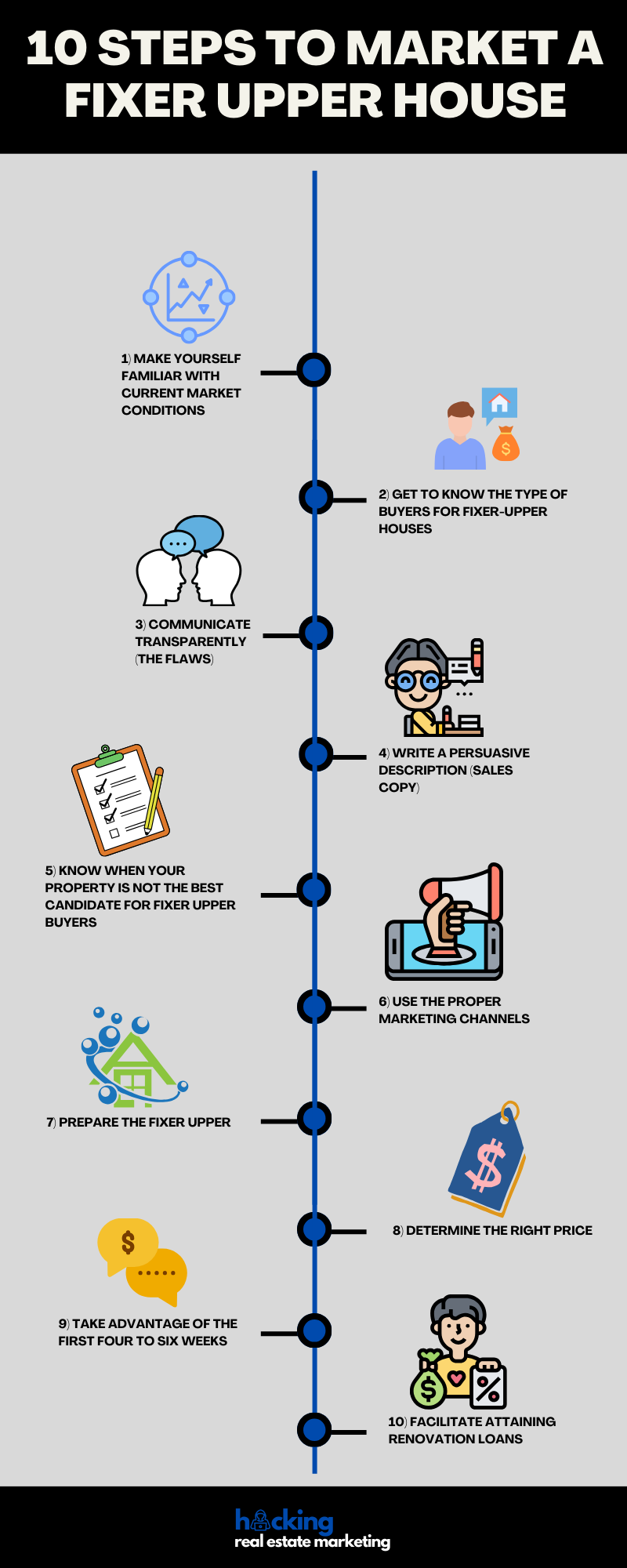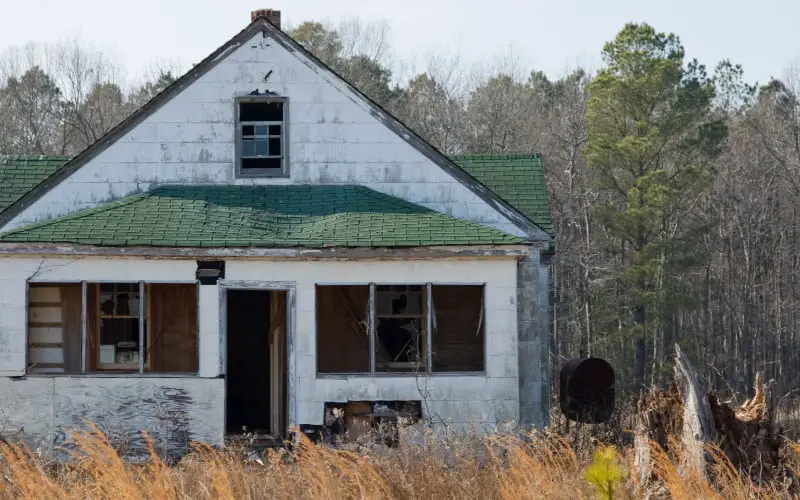Have a fixer-upper house and want to market and sell it?
These are the nine strategic steps involved:
- Make Yourself Familiar With Current Market Conditions for Fixer-Upper Houses
- Get to Know the type of buyers for fixer-upper houses
- Communicate transparently (the flaws)
- Write a persuasive property description
- Know when your property is not the best candidate for fixer-upper buyers
- Use the proper marketing channels to reach the ideal buyers
- Prepare your fixer-upper house
- Determine the right price
- Take advantage of the first four to six weeks on the market
- Facilitate attaining renovation loans
Let’s dive a bit deeper, explaining each of the steps.
1) Make Yourself Familiar With Current Market Conditions for Fixer-Upper Houses

Ideally, you want to put your fixer-upper on the market when the demand is rising and not declining.
But here is the thing.
According to reports from the Wall Street Journal and an article from Florida Realtors, the popularity is decreasing in 2023.
Why?
The article states, “The drop in demand for unrenovated homes is mostly driven by high mortgage rates, agents say.
Fixer-uppers are always a risky proposition for buyers, but now they’re more costly as the rates for home loans and construction loans have both increased – plus house prices remain high.
Agents say the appetite for fixer-uppers is lower both for people who are shopping for their main property as well as for second homes.”
2) Get to Know the Type of Buyers for Fixer-Uppers

To know how to market a fixer-upper house, we must also know what buyers buy these houses.
And there are about four types of buyers for fixer-upper houses:
The Deal Hunters
Deal hunters buy fixer-uppers in preferred areas.
It’s an affordable entry into otherwise unaffordable neighborhoods for them.
They improve the property over time.
This enhances its value, aligning closely with traditional residential homebuying patterns.
Buy and Hold Investor
Buying a fixer-upper in a seller’s market is also a buy-and-hold investor strategy.
It’s a strategic way to enter high-demand neighborhoods more quickly.
Buy-and-hold investors remodel these properties primarily for rental income.
Selling for profit is a secondary, long-term strategy.
Retail Remodelers
Retail remodelers are akin to buy-and-hold investors.
They acquire fixer-uppers in desired neighborhoods where high demand previously hindered purchase.
Unlike investors, they renovate these homes for personal use.
This is to use them as primary residences or second homes in prime locations.
I saw this happening in Cape Cod.
The Fix & Flippers
Fix & Flippers focus on buying low-priced houses.
They often do this at auctions to renovate and resell for a profit without intent to rent.
Renting out these properties becomes a secondary strategy.
This strategy can be a contingency if an immediate sale isn’t feasible. Or it’s a deliberate long-term flip with tax benefits.
3) Communicate Transparently

Most buyers mentioned above already know that the house they are looking for is a fixer-upper.
So there’s no need to describe things as better as they are or exaggerate.
Some features and related benefits are worth discussing and a little bragging about.
One of these things can be the history of the house.
Another point you can describe is what potential buyers could do with the house once it is fixed.
And flaws you want to communicate openly.
But also how they could be fixed.
If you have information about potential fixing costs, you might want to share that, too.
4) Write a Persuasive Property Description

The earlier step (transparent communication) is also vital when writing the fixer-upper description. That’s real estate sales copy.
For that, you can use the principles I covered already in the following articles:
- “How to Write a Listing Description that Actually Pops“
- “How to Market a Unique Property“
- “Real Estate Landing Pages – A Performance-Based Guide “
- “Sales Copy for Real Estate – The Ultimate Guide for Better Conversions.”
It again comes back to copywriting principles with the proper preparation.
Why?
The fixer-upper description’s purpose is not just to have a description.
Ideally, it’s to persuade the potential buyers of the fixer-upper through your words. By definition, selling with words is copywriting.
I will give you the steps below shortly, but if you want to dig deeper, I recommend you read the articles mentioned.
- Know who your buyer type will be
- Identify current and potential benefits of the fixer-upper. Why? To align them with the buyers’ needs, greed, and/or pains.
- Convert the features into benefits.
- To write the description, use one of the many copywriting formulas. That’s AIDA (attention, interest, desire, action) and/or PAS (problem, agitate, solve).
A Fixer Upper House Description Example
“Headline: Gründerzeit Fixer Upper in Houston Downtown with at least 80% ROI
Close to the center of Houston (TX), this raw diamond can give you an ROI of at least 80% when selling retail. Not to mention what you could do when you hold it.
It’s one of the rare six-bed, six-bath Renaissance revival houses that can tell you the long history of the Gründerzeit.
One of the Allan brothers (the city founders of Houston) had lived in it for over a decade; today, it could be yours, too.
Again, the 80% ROI is a pretty conservative estimation.
It could be easily turned into a multi-unit townhouse with the charming Renaissance revival style it still has. Why? Because of its closeness (10 minutes by car) to downtown.
So you can easily surpass the 80% ROI.
The parts of the house that look a bit sad and need fixing are the following:
- Bathroom fixtures
- 50% of the roof
- The wall between the kitchen and the living area
- Floors in two living rooms
However, the foundation still stands like on day one. It could beat the quality of some of the new buildings built today.
Contact us today at 123-123-1234 or by email at contact@wesellfixeruppers2023.com.
We are happy to send you more details about the things that need repairs and the concept of a new spatial plan.“
5) Know When Your Property Is Not the Best Candidate for Fixer Upper Buyers

You want to step into their shoes when thinking about marketing to fixer-upper buyers.
They usually look for properties with issues.
It’s issues like:
- Overgrown landscaping
- Peeling paint
- Solid but outdated construction
- Dark, outdated interiors.
Fixer-uppers with potential include:
- Homes with old kitchens and bathrooms
- Bad smells
- Roof leaks
- The layout is poor, with small rooms that can be opened up.
However, some properties are too far gone even for the most daring investors.
These include houses needing to be torn down.
They usually have major structural, environmental, or geological problems.
No matter how low the price, these are often seen as lost causes with no chance of a good return on investment.
6) Use the Proper Marketing Channels to Market Your Fixer Upper House to Buyers

Want to effectively market a non-teardown property to fixer-upper buyers?
Consider the following marketing channels:
Listing on Property Portals:
Advertise your fixer-upper on popular real estate platforms like Zillow and Redfin.
Your listing should highlight its potential for renovation.
Use niche portals dedicated to fixer-uppers and foreclosures for a more targeted approach.
You could use foreclosure.com, distressedpropertiessale.com, and freelistoffixeruppers.com.
Targeted Outreach to Investors:
Utilize Zillow or similar sites to identify areas with a high concentration of potential investor buyers.
His group includes those looking to buy, fix, and hold or flip properties.
You can find landlords or owners in lower price brackets who might be seeking additional investment properties.
Gather contact information from RedFin or county records for direct outreach.
Tools like Batchleads can also assist in this research.
You can reach out to these prospects by:
- Cold calling
- Direct mailing
- Targeted online campaigns (Facebook ads specific to geographical areas).
Engaging Specialized Realtors:
You can connect with realtors who specialize in fixer-upper properties through Zillow.
There, you can locate agents dealing with lower-priced homes similar to yours.
You can also search Google using terms like “fixer-upper realtors in [your location]” to find relevant agents and listings.
For example, you can search for fixer-upper agents in Miami, Florida, on websites like Redfin, Realtor.com, and Zillow.
The links for such searches usually look like this:
- https://www.redfin.com/state/Florida/fixer-upper
- https://www.foreclosure.com/florida/fixer_upper/
- https://www.zillow.com/tampa-fl/fixer-upper_att/.
Paid Online Advertising:
For Google Search Ads, focus on keywords related to fixer-uppers, such as ‘fixer-upper homes for sale’ and ‘fixer-uppers for sale near me.’
In Facebook Ads, you can target audiences interested in real estate investing, renovations, and related areas.
In addition, you can use the information you’ve gathered for custom and lookalike audiences.
Content Marketing & Local SEO:
As a long-term strategy, you can create content that ranks for local search terms related to fixer-upper homes.
This method takes time to yield results. But it can be highly effective in specific neighborhoods.
7) Prepare the Fixer Upper

You want to prepare your fixer-upper before running any advertising campaigns or marketing activities.
Yes, it’s a fixer-upper, but sometimes, you can make minor improvements that make even a fixer-upper more appealing.
Such things could be the following:
- cleaning the kitchen and bathrooms
- washing the floors and the windows
- sweeping away dust
- removing debris from the yard and the house
- remove unflattering furniture from the rooms
The goal here is to make it a bit easier for the potential fixer-upper buyer to imagine the fixed house of the future.
8) Determine the Right Price

Setting the right price for a fixer-upper means considering its good and bad points, like hardwood floors (a plus) or water damage (a minus).
There are three main ways to figure out a house’s value:
Sales Comparison: Look at what similar homes (same number of bedrooms, bathrooms, etc.) sold for in your area.
There are tools online to help with this.
Cost Approach: Calculate what it would cost to build a similar house today, adding the value of the land and subtracting any depreciation.
Income Capitalization: Most investors use this method.
It considers how much rental income the property could generate.
Let’s say a property could rent for $1,000 a month.
If the investor wanted a 10% annual return, they would value the house at $1000 x 12 months / 10%, minus any repair costs.
Repair costs are often estimated at $5, $10, or $15 per square foot, depending on the extent of the repairs needed.
The income capitalization approach is the most relevant as fixer-uppers primarily attract investors.
Knowing your price limit before negotiations start is key.
9) Take Advantage of the First Four to Six Weeks on the Market

The first four to six weeks you have a (fixer-upper) house on the market are typically the most active. (source)
This presents a little dilemma and conflicting goals when you want to sell a fixer-upper fast.
Why?
If you want to sell fast, you want to take advantage of these first and most active weeks. This relates to the offers you may receive.
And you don’t want to wait too long until you accept one of these offers.
On the other hand, you don’t want to act too fast and accept the first offer you get right away.
Why?
Because a better offer may beat it a little bit later.
So it’s a bit of an art to finding the middle ground here so you can sell fairly fast, but don’t accept a lowball offer right at the start just to sell fast.
Therefore, it’s essential you know how low you want to go, as previously mentioned.
10) Facilitate Attaining Renovation Loans

Are you in a position to facilitate getting renovation loans?
If yes, you might increase the response rate and/or conversion rate, at least for deal hunters (but not limited to them).
With a renovation loan, a fixer-upper buyer can get approved for a higher loan instead of buying the house and paying for the renovation.
They then get the approved funds in different phases to pay for larger renovations.
This can happen if their credit score checks out, and they can put some money down.
Additionally, a representative of the mortgage company needs to approve the renovation.

This article has been reviewed by our editorial team. It has been approved for publication in accordance with our editorial policy.
- Why Real Estate Conversion Rates Are 6-Times Below Average - March 21, 2024
- How to Manage Your Apartment Advertising Campaign - February 23, 2024
- Finding Marketing Channels for Apartment Advertising - February 12, 2024

